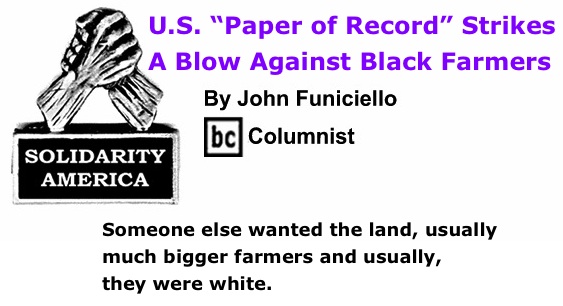




A New York Times reporter in late April wrote a piece titled, “U.S. Opens Spigot After Farmers Claim Discrimination,”
and opined that the structure of the settlement between black farmers
and the U.S. Department of Agriculture (USDA) had b888een a “magnet for
fraud.”
A latecomer to the issue of rampant discrimination against black
farmers, Sharon LaFraniere, filed a story that virtually ignored the
structural racism in most dealings between USDA’s most local level, the
“county committees” and black farmers. Rather, she reported that
bureaucrats inside the federal government, as well as the political
establishment, had said there “was no credible evidence of widespread
discrimination” against the black farmers who had made the charges.
The first question one would be inclined to ask is: What country did
she grow up in? And, has she learned anything about the struggle for
civil rights in the U.S. over the past century? A problem that she had
in researching (the term is used loosely) the story is that she is not
likely to have spoken at length with the farmers in the class action
lawsuit that had its origins nearly a quarter-century ago. The story
apparently was based solely on the assertions of those inside the USDA
who might have been some of those who actually presided over the
rampant discrimination in the first place. Or, they might have just
blindly carried out the discriminatory policies that were in place.
With some fanfare, the USDA revealed the settlement with black
farmers several years ago, with individual payments set at $50,000 for
each claimant. Some in the government thought that it was an
open-and-shut case, that there were just a few dozen claimants, who,
once they were paid, would cause the issue to disappear. The case was
much more complicated than that and, after Barack Obama became
president, the amount set aside for payout was $1.13 billion. That’s
how the number of claimants grew.
As in any litigation involving government and bureaucracy and the
principle of “discovery,” it was shown that many more farmers had
suffered regular discrimination by the county committees, which across
the South, were peopled primarily by white farmers. It was these
committees, black farmers claimed, who took the actions that nearly led
to the demise of black farm agriculture in most of the southern states.
The alleged fraud in claims came as the result of the opening of the
lawsuit to more black families who said they were victims of
discrimination. Many were sons or daughters or descendents of farmers
who suffered the discrimination all their lives and died before they
got their measure of justice. The increase in claims came largely as
the result of the notification of black communities by the USDA that
there was such a lawsuit.
The LaFraniere story resulted in a firestorm of criticism about the
tone and the facts (or lack thereof) of the story. Black farm
organizations, academics, and others pointed out the flaws in the piece
and showed that the research for the story was incompetent at best or
intentionally misleading.
One fact that seemed to evade Ms. LaFraniere, in her assessment of a
lack of discrimination is this: There were more than 900,000 black
farmers at about the end of World War I and, by the time those same
farmers were prepared to do something about it (somewhere around 1990),
there were said to be only 18,000 black farmers left and they were
being forced off their farms at an alarming rate. One would have to
avoid knowledge of the workings of Reconstruction after the Civil War
and of Jim Crow after World War I to not know the kind of naked racism
and discrimination that was being practiced routinely. So much for
there being “no credible evidence” of widespread discrimination…it was
there to be seen, even by a reporter in 2013. That is what the civil
rights movements were about.
In a letter in response to the LaFraniere story, Ralph Paige, executive
director of the Federation of Southern Cooperatives (FSC), wrote,
“Mainly, it does not offer historical context of the vast scope of
discrimination in rural areas throughout the country by the Agriculture
Department. It does not mention the decades of studies by the
Commission on Civil Rights and the Agriculture Department itself that
confirm discrimination against black farmers. It also does not mention
the countless black farmers who worked diligently on farm plans only to
have their loan applications thrown in the trash can right in front of
them by the Agriculture Department’s county supervisor.”
And that was the impunity with which the most local representatives of
the USDA acted throughout the generations, throughout the South. As an
aside, the only reason there was not the same problem in other regions
of the country was that there were so few black farmers, their numbers
did not register for agricultural statistics. The FSC has kept track of
these issues throughout its nearly 45-year history, during which it has
assisted black family farmers across the South with farm management,
debt restructuring, alternative crop suggestions, marketing expertise
and a whole range of services to ensure family farm survivability.
Also, Paige added: “Also, the fraud alleged in the article was
minuscule. The 60 claims investigated by the F.B.I. amounted to less
than three-tenths of 1 percent of the 22,000 claims filed.”
The discrimination the USDA was attempting to address occurred over
generations, not just since the beginnings of the class action lawsuit,
in the early 1990s. When it began, there were only about 18,000 black
farmers left on the land, while thousands of others still held the land
that had been farmed by parents or grandparents, who had been forced
out of farming by routine discrimination. One of the reasons for
pushing them off the land was that someone else wanted the land,
usually much bigger farmers and usually, they were white.
Rachel Slocum, a professor of geography at the University of
Wisconsin-LaCrosse, in a letter co-written by nine other academics from
several states, told the Times: “We do not deny the accuracy of the
claim that some fraud has occurred. In any sign-up program with tens of
thousands of participants and billions of dollars at stake, a few
people will try to cheat the system. Those who do should be punished.
The article is not really about those few proven cases, however. It is
instead an effort to depict the settlement, without providing any real
evidence, as a ‘runaway train’ of fraud.”
Agricultural historian, Pete Daniels, whose latest book,
“Dispossession: Discrimination Against African-American Farmers in the
Age of Civil Rights,” addressed the problems of integral discrimination
in the policies of the USDA, wrote of the LaFraniere story, “But there
is a long train of evidence of discrimination, much of it from the USDA
records at the National Archives, as well as from records of the U.S.
Commission on Civil Rights, National Sharecroppers Fund, NAACP, SNCC,
and land grant universities, among other sources. Since the mid-1960s,
USDA officials have continually denied discrimination, but the record
indicates otherwise.”
Daniels has concentrated on that long history of
discrimination before 1981, which was eventually made the cutoff year
for discrimination claims. Writing for the History News Network, his
contention is that the record is full of examples: “When SNCC (Student
Non-violent Coordinating Committee) in the mid-1960s organized African
American farmers to vote in ASCS (Agricultural Stabilization and
Conservation Service) elections, county offices issued inaccurate maps,
neglected to send black women ballots, manipulated ballots to confuse
black farmers, all with the complicity of the Washington USDA office.
“There was also violence, intimidation, and economic retaliation. Some
black farmers were eventually elected to community committees and a few
alternates elected to powerful county committees, but the system
remained tightly controlled by whites. Millions of dollars flowed
through these committees that in many ways shaped rural life. As the
civil rights movement wound down, USDA administrators belittled SNCC’s
contribution to organizing black farmers in ASCS elections,
outrageously claiming that it was the USDA that encouraged black
participation.”
There is enough evidence that discrimination was rampant through at
least three generations and we know that it did not stop with any
“settlement” made between the black farmers and the Department of
Agriculture or the government at any level. There are those who died
waiting for justice and, if their descendants did not make their claim,
the historical record might show that there was no justification for
the payments, as paltry as they were. A $50,000 payment for someone who
hung on for years and faced two or three times that amount in debt
would not represent justice. Fortunately, there are historians like
Daniels who will not let the historical record lie.
As Ralph Paige wrote, “One would hope that the Agriculture Department
would finally address the dreadful discrimination within its ranks, and
thanks to Secretary Tom Vilsack, it is doing precisely that. The
journey to overcome racial issues is not an easy one, but to ignore the
existence of this injustice is the very definition of discrimination.
Unfortunately, the article criticizes farmers who have been victimized
rather than the Agriculture Department’s history of corrupt policies.”
When this kind of lopsided coverage of an issue as vital as the demise
of black farmers and landowners is distributed around the country, it
is that story that is the one the general public remembers. Despite the
accurate portrayal of the issue by people like Ralph Paige, Rachel
Slocum, and Pete Daniels, it is the New York Times version that is
likely to be remembered, because any number of newspapers large and
small, as well as other news outlets, will have used the story, as is,
and there is no counter to the power of the mainstream media.
In recent years, there have been numerous stories in the press about
the “land grabs” by the richer nations, mostly in the global south, in
which corporations, governments, and private individuals are taking
control of large swaths of poorer countries to grow food and cash crops
for their own countries. Many developing countries in Africa have
fallen prey to the land grabbers and have seen tribal and indigenous
people removed from the land. In reality, the land grab of millions of
acres of American soil that was once owned by black farmers has been
going on for the better part of a century and it happened under the
noses of virtually all Americans.
Gary Grant, president of the Black Farmers and Agriculturalists
Association (BFAA), said many years ago, when he was gearing up for the
discrimination lawsuit on his parents’ farm in North Carolina, “A
landless people is a powerless people.”
That appears to have been the long-term goal of those who worked so
hard for so many decades to eliminate black farmers in America.

BlackCommentator.com Columnist, John Funiciello,
is a long-time former newspaper reporter and labor organizer, who lives
in the
 |






